In celebration of Wound, Ostomy, and Continence (WOC) Nurse Week 2021, help us to shine a bright light on these special nurses. They give us the hope, support, and specialized care needed to thrive in life with an ostomy.
WOC nurse volunteers spend countless hours advocating, leading support groups, educating, fundraising, and supporting UOAA programs and services. UOAA recognizes that not all ostomy patients have access to a WOC nurse and we’ll continue to advocate for access to a specialized ostomy nurse from preoperatively when your stoma site is marked through an ongoing lifetime continuum of care as outlined in our Ostomy and Continent Diversion Patient Bill of Rights.
We asked UOAA’s social media community to share how a WOC nurse has made a difference in your life, health, or support group. We hope more nurses will consider this rewarding specialty. Thank you WOC nurses, you are our guiding lights.
I would like to thank my WOC nurses who have and continue to support me as an ostomate. My nurses inspired me so much I went to nursing school and graduate this month with a BSN and plan on continuing on. To become a WOC nurse myself! Thank you WOC nurses! -Katie Lee
“My WOC was a lady named Gayle. She helped my Mom so much with me. I remember many visits to the ER ward and having her there. She was funny, nice and on it. I used to love seeing her. She stayed by my side from 3-6yr old into my adulthood. She fought hard to find a bag that was the perfect fit for me. She got a new product in and it changed my life significantly, she fought tooth and nail to keep me in that bag, even when Canada decided to stop offering it openly. I still wear that brand to this day. I always heard rumors she was also an Ostomate and I can’t say how long. That made me love her more. I will never forget those who had a hand in my welfare and saw me through their entire career. I miss her and the others immensely. Jody is my new WOC and although I rarely need her, she’s there to help, even if it’s a panic situation that couldn’t wait for an appointment.” –Camille C.
“Joanna Burgess Happy WOC Nurse week. You have been a true Angel of Mercy for me over the years!” –Col Justin Blum
“My son’s WOC nurses at CHLA were awesome!!” – Teri C.
I am a WOCN and worked with MANY ostomy patients in the past. The thanks go both ways — I have never (in a long nursing career) felt as appreciated for my clinical skills and assistance as I do when working with people with an ostomy. They are the reason I have stayed in nursing. -Cris R.

This is Karen with my husband at his 55th birthday party in 2019 -Pam Allen Williamson
We have 3 great WOC nurses in our community that come to our ostomy support meetings Karen Eubank, Michael Byars and Jason Pratt. Michael went above and beyond by creating a weekly outpatient ostomy clinic after I told him I learned some cities had those while attending a UOAA conference. Karen who has been coming to our meetings for over a decade, hosts many of our support group parties at her house, works at the ostomy clinic on a regular basis, pays to store donated supplies and often helps people after hours. Both of them visit my husband when he is hospitalized, came to the house to visit him when he was home on hospice and came to his funeral. We are extra grateful to Karen because before he left the hospital on hospice she applied a special high output bag connected to bed drainage bag to minimize the family’s need to interact with the ostomy. Karen who is a neighbor told me that she would come change the bag twice a week. The hospice nurse was fascinated and stayed late to watch Karen change it out. He was going to stay in the hospital as long as they would let him to avoid family having to deal with his bag because he had always been so independent with it until nearly the end. Karen’s solution allowed him to come home and be surrounded by family caregivers that loved him and have wonderful conversations remembering fun times and having important conversations instead of the visitor limitations hospitals right now. We are so grateful to her for this and hope it will benefit other families of bed-bound patients. BTW we still fondly remember my husband’s first WOCN Nurse Licklighter who was a nurse at Keesler AFB in 1993. She marked him before surgery and taught him how to handle his bag and he kept her handwritten instructions forever and sometimes copied them for others. -Pam A.W.
I can’t thank the nurses at Ohio Health Riverside Hospital they helped me so much and made an otherwise difficult transition quite non traumatic! –Carol B.
Thank you to Erin and Vanessa at New York Presbyterian! –Jameson Cycz
The ConvaTec nurse Lorelei. She has been a stoma saver. She helped me troubleshoot my leaking problem, got me into a new pouching system, that is awesome and when I ran out of samples and am in limbo with my supply company in getting the new pouches and other supplies, she set me up with a holdover supply, so that my stoma won’t be continuously injured by my current pouches.- Susan Gentner
 I’m thankful for all of the WOCNs I have been to. Some I’ve known for many years. They are very knowledgeable and helpful with various products.I also want to give a shoutout to our great WOCNs at 11 Health & Technologies for being amazing for our team and patients. ? –Megan Alloway
I’m thankful for all of the WOCNs I have been to. Some I’ve known for many years. They are very knowledgeable and helpful with various products.I also want to give a shoutout to our great WOCNs at 11 Health & Technologies for being amazing for our team and patients. ? –Megan Alloway
Amazing Aimee Frisch. The best WOCN in know. Love you. -John Pederson
Happy #WOCNurseWeek2021! What you do for ostomy patients and the impact you make is immeasurable! Plus we are grateful for all that you do to support UOAA and our advocacy program! You are advocates for patients and can influence change. Shine on! @UOAA_Advocate -Jeanine Gleba









